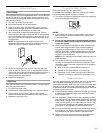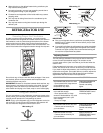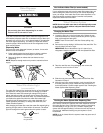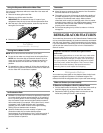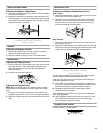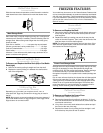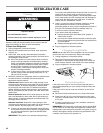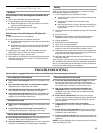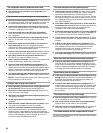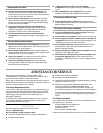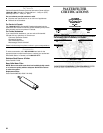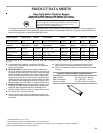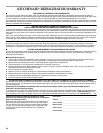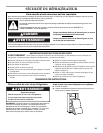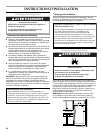
19
Vacation and Moving Care
Vacations
If You Choose to Leave the Refrigerator On While You’re
Away:
1. Use up any perishables and freeze other items.
2. If your refrigerator has an automatic ice maker:
■ Raise wire shutoff arm to OFF (up) position or move the
switch to the OFF (right) setting.
■ Shut off water supply to the ice maker.
3. Empty the ice bin.
If You Choose to Turn the Refrigerator Off Before You
Leave:
1. Remove all food from the refrigerator.
2. If your refrigerator has an automatic ice maker:
■ Turn off the water supply to the ice maker at least one day
ahead of time.
■ When the last load of ice drops, raise the wire shutoff arm
to the OFF (up) position or move the switch to the OFF
(right) setting.
3. Depending on the model, turn the Thermostat Control or
Refrigerator Control to OFF. See “Using the Controls.”
4. Clean refrigerator, wipe it, and dry well.
5. Tape rubber or wood blocks to the tops of both doors to prop
them open far enough for air to get in. This stops odor and
mold from building up.
Moving
When you are moving your refrigerator to a new home, follow
these steps to prepare it for the move.
1. If your refrigerator has an automatic ice maker:
■ Turn off the water supply to the ice maker at least one day
ahead of time.
■ Disconnect the water line from the back of the
refrigerator.
■ When the last load of ice drops, raise the wire shutoff arm
to the OFF (up) position or move the switch to the OFF
(right) setting.
2. Remove all food from the refrigerator and pack all frozen food
in dry ice.
3. Empty the ice bin.
4. Depending on the model, turn the Thermostat Control or
Refrigerator Control to OFF. See “Using the Controls.”
5. Unplug refrigerator.
6. Empty water from the defrost pan.
7. Clean, wipe, and dry thoroughly.
8. Take out all removable parts, wrap them well, and tape them
together so they don’t shift and rattle during the move.
9. Depending on the model, raise the front of the refrigerator so
it rolls more easily OR screw in the leveling legs so they don't
scrape the floor. See “Adjust the Doors.”
10. Tape the doors closed and tape the power cord to the
refrigerator cabinet.
When you get to your new home, put everything back and refer to
the “Installation Instructions” section for preparation instructions.
Also, if your refrigerator has an automatic ice maker, remember to
reconnect the water supply to the refrigerator.
TROUBLESHOOTING
Try the solutions suggested here first in order to avoid the cost of an unnecessary service call.
Your refrigerator will not operate
■ Is the power cord unplugged? Plug into a grounded 3 prong
outlet.
■ Has a household fuse blown or circuit breaker tripped?
Replace the fuse or reset the circuit breaker.
■ Is the Refrigerator Control turned to the OFF position?
See “Using the Control(s),” depending on the model.
■ Is the refrigerator defrosting? Recheck to see whether the
refrigerator is operating in 30 minutes. Your refrigerator will
regularly run an automatic defrost cycle.
The lights do not work
■ Is the power cord unplugged? Plug into a grounded 3 prong
outlet.
■ Is a light bulb loose in the socket or burned out? See
“Changing the Light Bulb(s),” depending on the model.
There is water in the defrost drain pan
■ Is the refrigerator defrosting? The water will evaporate. It is
normal for water to drip into the defrost pan.
■ Is it more humid than normal? When it is humid, expect that
the water in the defrost pan will take longer to evaporate.
The motor seems to run too much
■ Is the room temperature hotter than normal? The motor
will run longer under warm conditions. At normal room
temperatures, your motor will run about 40% to 80% of the
time. Under warmer conditions, it will run even more.
■ Has a large amount of food just been added to the
refrigerator? Adding a large amount of food warms the
refrigerator. The motor normally will run longer to cool the
refrigerator back down.
■ Are the doors opened often? The motor will run longer
when this occurs. Conserve energy by getting all items out at
one time, keeping food organized, and closing the door as
soon as possible.
■ Is the control set correctly for the surrounding
conditions? See “Using the Control(s),” depending on the
model.
■ Are the doors closed completely? Close the doors firmly. If
they do not close completely, see “The doors will not close
completely” later in this section.
■ Are the condenser coils dirty? This prevents air transfer and
makes the motor work harder. Clean the condenser coils. See
“Cleaning.”
NOTE: Your new refrigerator will run longer than your old one due
to its high-efficiency motor.



